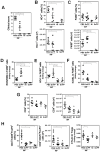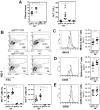Heme-Oxygenase-1 Attenuates Oxidative Functions of Antigen Presenting Cells and Promotes Regulatory T Cell Differentiation during Fasciola hepatica Infection
- PMID: 34943041
- PMCID: PMC8750899
- DOI: 10.3390/antiox10121938
Heme-Oxygenase-1 Attenuates Oxidative Functions of Antigen Presenting Cells and Promotes Regulatory T Cell Differentiation during Fasciola hepatica Infection
Abstract
Fasciola hepatica is a fluke that infects livestock and humans causing fasciolosis, a zoonotic disease of increasing importance due to its worldwide distribution and high economic losses. The parasite regulates the host immune system by inducing a strong Th2 and regulatory T (Treg) cell immune response through mechanisms that might involve the expression or activity of heme-oxygenase-1 (HO-1), the rate-limiting enzyme in the catabolism of free heme that also has immunoregulatory and antioxidant properties. In this paper, we show that F. hepatica-infected mice upregulate HO-1 on peritoneal antigen-presenting cells (APC), which produce decreased levels of both reactive oxygen and nitrogen species (ROS/RNS). The presence of these cells was associated with increased levels of regulatory T cells (Tregs). Blocking the IL-10 receptor (IL-10R) during parasite infection demonstrated that the presence of splenic Tregs and peritoneal APC expressing HO-1 were both dependent on IL-10 activity. Furthermore, IL-10R neutralization as well as pharmacological treatment with the HO-1 inhibitor SnPP protected mice from parasite infection and allowed peritoneal APC to produce significantly higher ROS/RNS levels than those detected in cells from infected control mice. Finally, parasite infection carried out in gp91phox knockout mice with inactive NADPH oxidase was associated with decreased levels of peritoneal HO-1+ cells and splenic Tregs, and partially protected mice from the hepatic damage induced by the parasite, revealing the complexity of the molecular mechanisms involving ROS production that participate in the complex pathology induced by this helminth. Altogether, these results contribute to the elucidation of the immunoregulatory and antioxidant role of HO-1 induced by F. hepatica in the host, providing alternative checkpoints that might control fasciolosis.
Keywords: ROS/RNS; antigen presenting cell; helminth; heme-oxigenase-1; immunoregulation; regulatory T cell.
Conflict of interest statement
The authors declare no conflict of interest.
Figures









References
-
- Mas-Coma S., Valero M.A., Bargues M.D. Fascioliasis. Adv. Exp. Med. Biol. 2019;1154:71–103. - PubMed
-
- Rodríguez E., Carasi P., Frigerio S., Da Costa V., van Vliet S., Noya V., Brossard N., Van Kooyk Y., García-Vallejo J.J., Freire T. Fasciola hepatica Immune Regulates CD11c+ Cells by Interacting with the Macrophage Gal/GalNAc Lectin. Front. Immunol. 2017;8:264. doi: 10.3389/fimmu.2017.00264. - DOI - PMC - PubMed
-
- Dowling D.J., Hamilton C.M., Donnelly S., La Course J., Brophy P.M., Dalton J., O’Neill S.M. Major Secretory Antigens of the Helminth Fasciola hepatica Activate a Suppressive Dendritic Cell Phenotype That Attenuates Th17 Cells but Fails to Activate Th2 Immune Responses. Infect. Immun. 2010;78:793–801. doi: 10.1128/IAI.00573-09. - DOI - PMC - PubMed
Grants and funding
LinkOut - more resources
Full Text Sources

